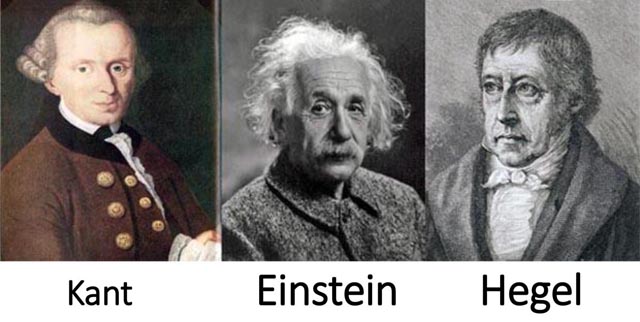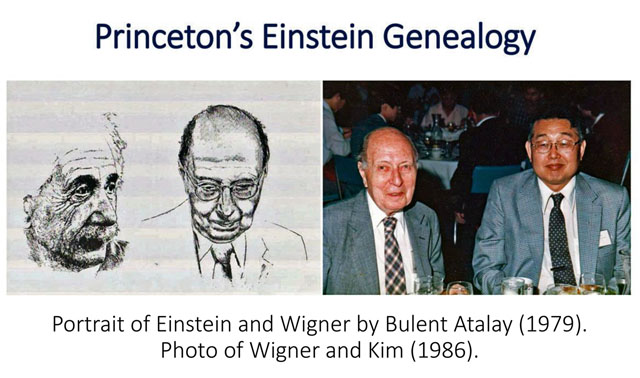|
Click here for Einstein's E = mc2 derivable from the Heisenberg brackets. |
Y. S. Kim's Einstein Page
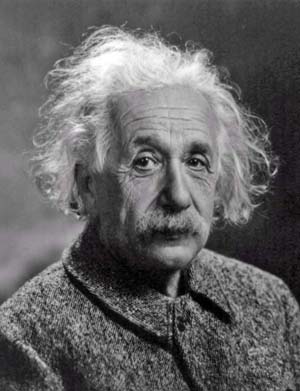
|
|

|
this photo of mine in 1961. |
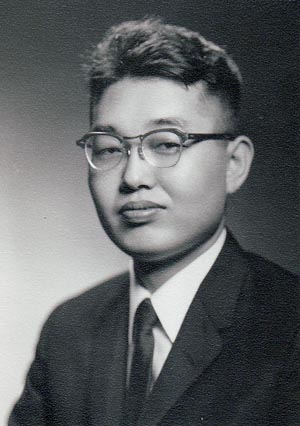
|
- I knew Eugene Wigner, and I have a number of photos with him. Here is
one of them. Wigner met Einstein
in Germany before they came to Princeton. I also published seven papers
with Wigner.
- Orren Jack Turner was Princeton's prominent photographer, and he took this photo of Einstein in 1947 (now in the public domain). In 1961, he took a photo of mine the day before my commencement.
Einstein formulated his special relativity in 1905. One hundred years later, in 2005, he came to me and asked me what I have done to make him happy. I told him I constructed this website for him, and I obtained the following research results for him.
- Einstein developed his relativistic dynamics for point particles.
However, what happens when the particle has internal space-time degrees of
freedom or an internal space-time extension? His energy-momentum relation,
known as E = mc2 , seems to work for all particles.
Can then his special relativity explain the internal space-time symmetry
and space-time extension? This has been and still is my main subject of
interest.
Click here for details.
These days, some people say that we need a new Einstein (Einstein of the 21st-century) to solve the the mystery inside the relativistic extended particles. I do not agree with them. I like the original Einstein, and I like to insist that Einstein prevails both in and outside the relativistic particle.
- Einstein and Bohr met often, but Einstein
was against the Copenhagen interpretation of quantum mechanics. Then what
did they talk about?
Bohr was interested the hydrogen atom while Einstein was worrying about how things look to moving observers. They met often before and after 1927. They then must have talked about how the hydrogen atom looks when it moves, but there are no written records about their conversation.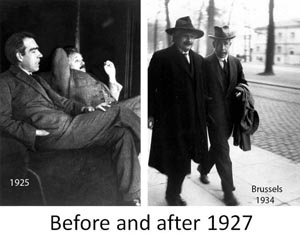
It is possible that they never talked about this problem. In either case, I have been worrying about this problem since 1957 when I learned Bohr's hydrogen atom and Einstein's Lorentz transformations during my undergraduate years at Carnegie Mellon University (1954-58). Is it possible to Lorentz-transform the electron orbit of the hydrogen atom?
- I am not the first one to see the problem. How can you Lorentz-boost
localized wave functions?
- Paul A. M. Dirac devoted a major portion of his research life to
this problem. He was interested in solving this problem using
harmonic oscillator wave functions.
- In 1939, Eugene P. Wigner constructed subgroups of the Lorentz
group which leave the four-momentum of a given particle invariant.
These subgroups then dictate the internal space-time structure of
the particle. If the hydrogen atom is a particle, its electron
orbit is its internal space-time structure.
- Richard P. Feynman made a major contribution toward making quantum
mechanics relativistic. He invented Feynman diagrams which constitute
the essential tool for understanding scattering problems. For
bound state, he suggested harmonic oscillators (1971).
In 1969, Feynman suggested his parton picture to tell how bound states look to an observer moving with a speed close to that of light.
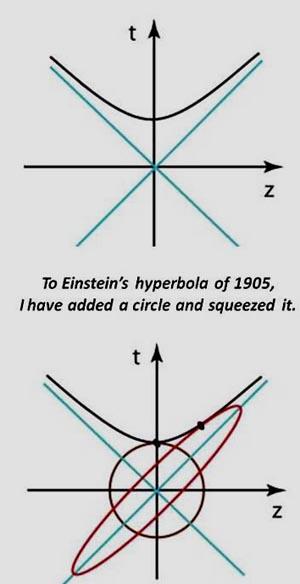
-
I learned the mathematics of these figures during my high-school
years (1951-54), even though I did not know they have anything
to do with Einstein.
It is possible to integrate the works of Dirac, Wigner, and Feynman to obtain the Bohr-Einstein picture of moving bound states. Click here for a more detailed story. For carrying our this job, the most influential person was Paul A. M. Dirac.
I did not have to invent new mathematics. The mathematical framework was based on what I learned during my high-school years (1951-54).
- Paul A. M. Dirac devoted a major portion of his research life to
this problem. He was interested in solving this problem using
harmonic oscillator wave functions.
- Einstein is much more than a physicist. Many people attempted to find
his coordinate among the well-established philosophers.
Kant and Hegel are among the philosophers most familiar to us. Einstein studied Kant very rigorously when he was a high-school student. It is a well-accepted view that Einstein was heavily influenced by Kant when he formulated his theory of relativity in 1905. However, this theory is not fully consistent with Kantianism. Then, where does Einstein stand? Einstein used a Hegelian approach when derived his E = mc2. He started as a Kantianist but became a Hegelianist while doing his physics.
Historically Hegel came after Kant. Thus, many people wrote articles about the transition from Kant to Hegel using historical and social developments, but I do not understand them. Indeed, Einstein clearly spelled out how this transition takes place in his approach to physics. In so doing, he Einstein placed both Kant and Hagel into one box.
Clck here for a story. - When Isaac Newton formulated his physical
laws, he had to invent a new
mathematics now called calculus. Not only in mechanics, calculus is the
indispensable mathematical tool for all branches of science.
When Einstein formulated relativity, he needed a new mathematics now called the Lorentz group. Thus, it is not crazy to expect that the Lorentz group is applicable to branches of physics other than relativity.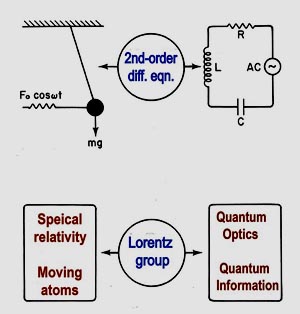
It is remarkable that classical ray optics, as well as quantum optics, can be formulated in terms of the Lorentz group. Special relativity explains what happens in optics, and optics can provide analog computers for special relativity.
Click here for some of the recent results on this subject. - Click here for more about Einstein.
This page is maintained by Y. S. Kim.
Photos of Bohr and Einstein are from the AIP E. Segre Visual Archives. <
